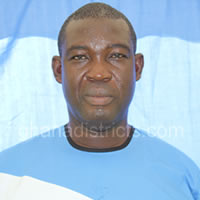Soils and suitability for Agriculture
The predominant soil types in the district are the black clays classified as Akuse series (Map 2.3) in the large central to eastern parts of the district. The soils are highly elastic when wet but become hard and compact when dry and then crack vertically from the surface. This renders the soil unsuitable for hand cultivation. Cultivation in the Akuse series dominated areas is confined mainly to small amounts of subsistence cropping of cassava, okro, maize and other vegetables. The short type grassland covering the Akuse series provides extensive grazing fields. The Black clays are considered highly suitable for development by mechanized irrigation farming.
At the gentle foot slopes of the Akwapim Range north of Dodowa, Agomeda and Ayikuma occurs an accumulation of slope wash from the hills above. The slope wash material consists predominantly of the Oyarifa series. These are deep, red, well-drained loamy soils. Here crops such as cassava, cocoyam and to a larger extent maize are best suited. Mangoes are also largely grown in the Dodowa areas. The soil types, which occur further east of Dodowa, within the Doryumu and Kordiabe areas, are of the Simpa-Doryumu-Agartar-Association. These are brownish grey, slight humus, medium or coarse sand, underlain by a hard porous gristly loam. The soils have low nutritional status and are quick in becoming parched after the end of the rainy season. Main crops grown here include pepper, okro, watermelon and maize.
Other soil types identifiable are those classified locally as the Agawtaw series found on the extreme eastern to southeastern part of the district around Agortor, Dawa and Minya. The soils here consist of grey-brown soils loamy for about 15-30 centimeter at the surface than abruptly changing to impervious clay which contains lime concretion below a depth of 60 centimeters. The topsoil rapidly becomes draughty during the dry seasons. This type of soil fairly supports any level of crop production. Most parts of the area are, however, left for grazing purposes. In the extreme north and northeast of the district occurs the Volta Alluvium, which makes up the Volta flood plain.
The soils classified as an association of Amo and Tefle series consists more or less have poorly drained pale-colored sandy silty and clay soils developed in recent or contemporary Volta Alluvium.
The soils appear to be moderately well supplied with nutrients under natural conditions and are easily workable even with simple implements. A greater portion of it in recent past was placed under extensive sugar cane cultivation to feed the now collapsed Asutsuare Sugar complex. The same fields are currently place under extensive rice cultivation making the flood plain soils one of the most fertile soils in the Dangme West District.
At the coastal south, the predominant soil type is associated with coastal sand dunes, backed by a discontinuous series of narrow, saline or brackish lagoons. These soils to some extent support coconut growth.
Lastly, the type of soils classified as Toje-Agawtaw series covers the area along the road to Ada and located at the southern sections of the Agawtaw series. It is made up of a mixture of red soils developed over tertiary deposits on the uplands and grey-brown impervious clays of Agawtaw series. These soils absorb moisture freely except when left bare. Under the prevailing climatic conditions they tend to be draughty in the topsoil. but lower layers have a good moisture storage capacity. These soils, to some extent, are favored for cultivation as they are easily workable. However, the application of frequent cover crops or the addition of farmyard manure will be essential if intensified crop production is to be maintained.
Current Agricultural Land use
In spite of the fact that soils in the district have fairly low fertile levels and also remain dry for most parts of the year due to the unreliable and deficient nature of the rainfall, there are still enormous potentialities, for agricultural development and expansion. The combination of the physiographic, which is, gently undulating and forming a large expanse of low plains coupled with ample supply of water from the Volta River are some of the factors, which account for the potentialities.
Extensive irrigation of the low plains over the Akuse soil series with water drawn from the Volta can afford these soils to be placed under extensive rice, maize and vegetable cultivation. The initial success of the Dawhenya Irrigation project that covers just a fraction of the land is a clear pointer to the fact that the provision of large-scale irrigable water can transform the low plains into a lucrative agricultural area. The area on the immediate east of Dodowa can attract drought resistant crops such as millet, cowpea, Soya beans, cotton and water melon, which is already being cultivated. The area is also suitable for pepper and okro cultivation.
Cotton in particular, which requires a long period of sunshine, could be introduced as a new crop in this part of the district. The low and undulating nature of the plain coupled with the absence of tree stumps provides an excellent opportunity for a large - scale mechanization. In other areas the ox-plough system of cultivation could be deployed backed by irrigation for the cultivation of cereals.
The Volta flood plains in the North are suitable for the cultivation of rice, sugar cane and vegetables. The extensive sugar cane cultivation to feed the Asutsuare sugar factory would have to be resuscitated. Otherwise, rice cultivation can be expanded through mechanization and irrigation.
Areas around most of the isolated hills can be reserved for forestry purposes in order to counteract the periodic bushfires and also protect the areas of wildlife resources. The poor nature of soils towards the south can hardly support any meaningful cropping. These parts of the district can be used for livestock rising with the possibility of growing improved pastures. The area south of the Agawtaw series soil type and north of the coastal sand dunes covered by the Toje-Agawtaw series could also be utilized effectively under dry farming methods. With dependence on farmyard manure (cow dung) closely, parts of the area can be used for the cultivation of cowpeas, millet, groundnuts, Soya beans and pepper. On the southern coast, the sandy soils are likely to support some form of coconut plantation.
Date Created : 11/24/2017 1:59:53 AM





